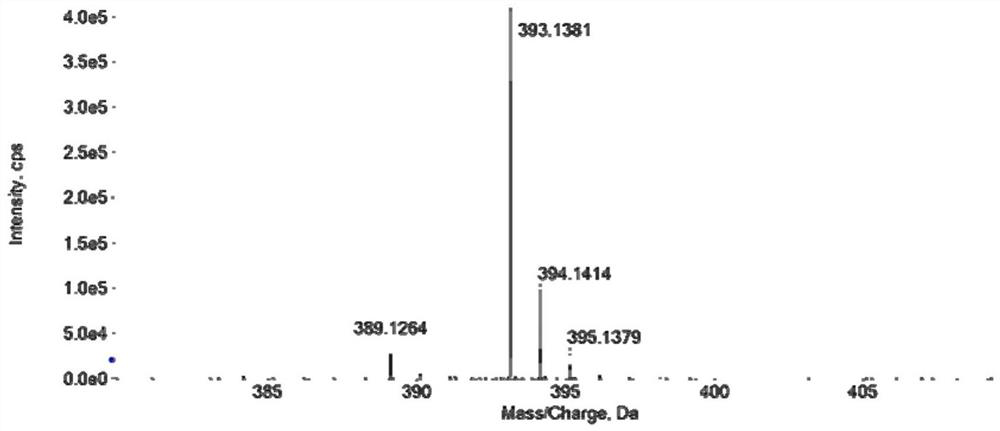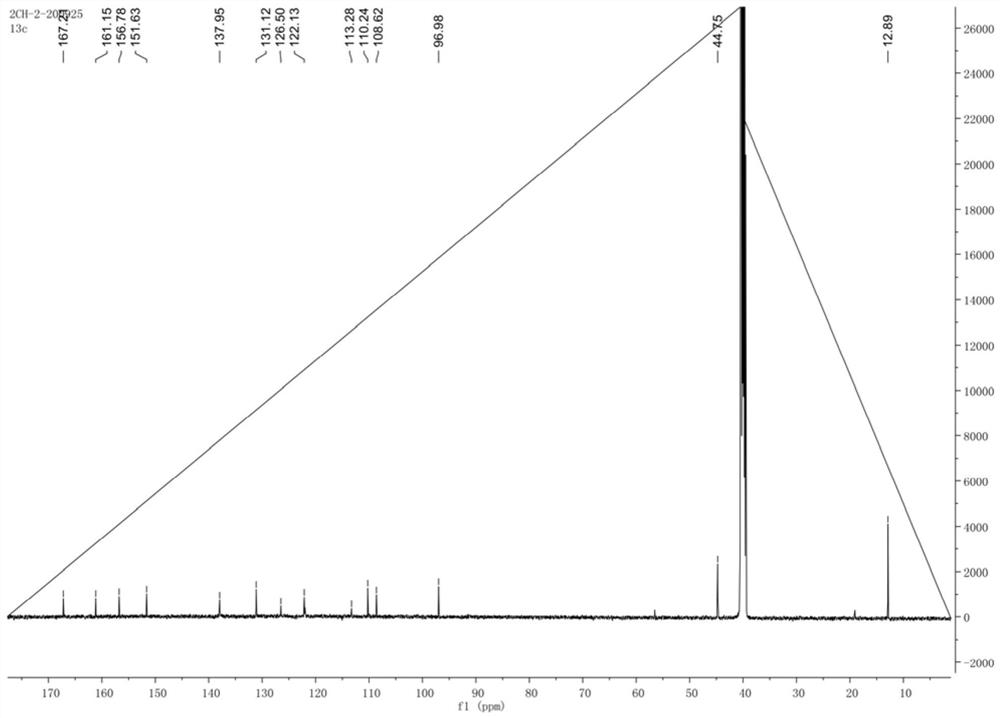Small-molecular fluorescent HClO probe, as well as preparation method and application thereof
A small molecule, fluorescent technology, applied in the field of preparation and small molecule fluorescent probes, can solve problems such as insufficient exploration of biological or environmental detection application potential, unsatisfactory sensitivity and/or selectivity, and complex HClO probe synthesis procedures. , to achieve the effect of good application prospect, low detection limit and convenient operation
- Summary
- Abstract
- Description
- Claims
- Application Information
AI Technical Summary
Problems solved by technology
Method used
Image
Examples
Embodiment 1
[0031] Example 1: Synthesis of Small Molecule Fluorescent Probes
[0032] The chemical formula of the synthetic small molecule fluorescent probe is as follows figure 1 Shown, wherein EtOH is ethanol, RT is room temperature.
[0033] The specific synthesis process is as follows: Dissolve 7-(diethylamino)coumarin-3-carbaldehyde (500mg, 2.04mmol) in 30mL ethanol solution, and add 2-hydrazinobenzothiazole (336mg, 2.04 mmol) and stirred at room temperature for 16 h, the reactant was filtered through a Buchner funnel, washed and dried with ethanol to obtain a green target probe solid. Such as figure 2 , 3 As shown, the product can be determined to be the target small molecule fluorescent probe by means of mass spectrometry, NMR and spectroscopy.
Embodiment 2
[0034] Example 2: Ultraviolet, fluorescence spectrum and fluorescence colorimetric analysis of small molecule fluorescent probes in response to hypochlorous acid to test HClO
[0035] Prepare 0.5mL small molecule fluorescent probe (10.0×10 -6 mol / L) in EtOH / PBS (v / v=2 / 8, pH-7.4) solution. 0-30 μM hypochlorous acid solution was added dropwise to the probe solution, as Figure 4 As shown in (A), after adding hypochlorous acid to the probe solution, the main absorption band at 450nm gradually weakens, and there is a new absorption peak at ~550nm, and its absorption intensity increases gradually with the concentration of HClO ions. The inner figure shows that the color of the fluorescent probe solution changes from green to colorless after adding hypochlorous acid, so that the colorimetric detection of hypochlorous acid can be realized.
[0036] In the fluorescence titration experiment, prepare 3mL small molecule probe (10.0×10 -6 mol / L) in EtOH / PBS (v / v=2 / 8, pH-7.4) solution. ...
Embodiment 3
[0037] Embodiment 3: verification small molecule fluorescent probe is to hypochlorous acid selectivity, response speed and pH adaptability
[0038] Prepare 5mL molecular probe (10.0×10 -6mol / L) in EtOH / PBS (v / v=2 / 8, pH-7.4) solution. Various interfering media solutions (1: HNAP-hdbt, 2: OH, 3: AcO - ,4:SO 3 2- ,5:O 2 - ,6:SO 4 2- ,7:HClO,8:NO 3 - ,9:H 2 o 2 ,10:Cys,11:GSH,12:PO 4 2- , 30.0×10 -6 mol / L). Subsequently, equal equivalents of hypochlorous acid solution and these interfering media were added to the probe solution, respectively. Detection is carried out by fluorescence spectrum, and the ratio of fluorescence emission wavelength (F 478 / F 528 )comparing. The results show( Figure 5 A), these interfering media have no obvious changes in the fluorescence of the probe as hypochlorous acid, which belong to the ROS series OH, H 2 o 2 There was also no noticeable impact. Only after adding hypochlorous acid, the fluorescence ratio of the probe solution ...
PUM
 Login to View More
Login to View More Abstract
Description
Claims
Application Information
 Login to View More
Login to View More - R&D
- Intellectual Property
- Life Sciences
- Materials
- Tech Scout
- Unparalleled Data Quality
- Higher Quality Content
- 60% Fewer Hallucinations
Browse by: Latest US Patents, China's latest patents, Technical Efficacy Thesaurus, Application Domain, Technology Topic, Popular Technical Reports.
© 2025 PatSnap. All rights reserved.Legal|Privacy policy|Modern Slavery Act Transparency Statement|Sitemap|About US| Contact US: help@patsnap.com



